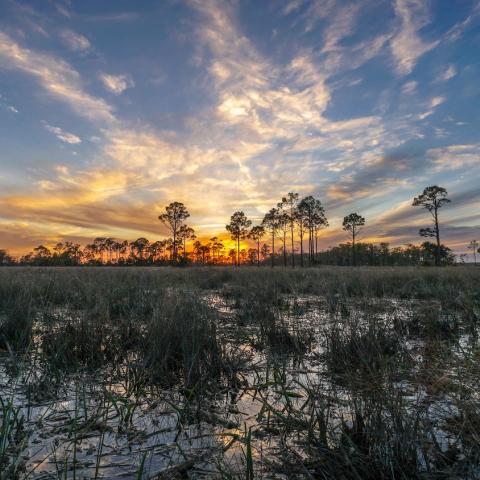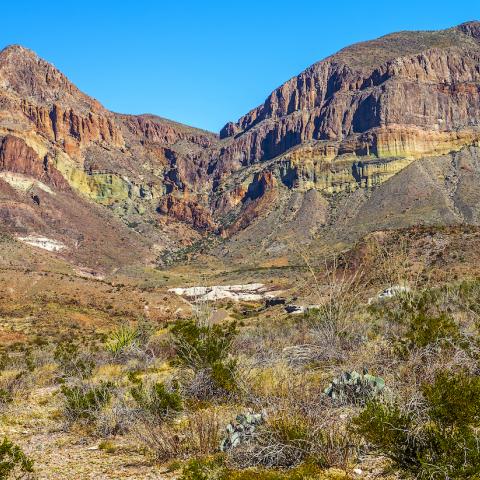
Ocotillo blooms, no flash, Big Bend National Park / Rebecca Latson
A flash? A reflector? For national park photography? Really? I'm sure many of you do pack one or the other into a national park. For those of you who do not, here's why you should think about doing so.

Ocotillo blooms with flash, Big Bend National Park / Rebecca Latson
Let’s say you are hiking a national park trail and come across a lovely morning or evening vista. You want to photograph this landscape that has a light horizon and a dark ground. Normally, you’d pull out your graduated neutral density filter (grad ND) to keep from blowing out (overexposing) the horizon while exposing for the dark ground. But, what if you want to clearly capture a plant or tree or person in the foreground of this same scene? Or, maybe you want to photograph a person or plant standing with the sun in the background (that’s called “backlighting”). Perhaps, along that same trail, you spy a gorgeous flower or unusual plant, and the inside of the flower or the plant’s stems or leaves are deeply shaded. Our eyes are great at distinguishing those nuances between light and dark and can pick out the detail in the shaded portions, but, while the camera does pick up the detail, you probably won't immediately see this detail without a fair bit of photo editing afterwards to lighten up those shaded areas.
Fill Flash
Ever heard of “fill flash”? Wedding photographers make great use of this for those lovely bride & groom images with the sunset filling the background. Fill flash brings out the shadowed areas and produces a nice light on the subject while allowing the colors and lighting of the background to remain unchanged.

The photographer on Lost Mine Trail, no flash, Big Bend National Park / Rebecca Latson

The photographer on Lost Mine Trail with flash, Big Bend National Park / Rebecca Latson
Below are some images captured with and without flash during my spring 2016 stay in Big Bend National Park, Texas. Which appeals to you more? I will admit that I like better some of the non-flash images, but there are a few taken with a flash that I prefer. So I'm glad I brought along my flash.

Prickly pear cactus bloom, no flash, Big Bend National Park / Rebecca Latson

Prickly pear cactus bloom with flash, Big Bend National Park / Rebecca Latson

Texas rainbow cactus, no flash, Big Bend National Park / Rebecca Latson

Texas rainbow cactus with flash, Big Bend National Park / Rebecca Latson

Pitaya cactus blossoms, no flash, Big Bend National Park / Rebecca Latson

Pitaya cactus blossoms with flash, Big Bend National Park / Rebecca Latson
You may note some shadowing in the images, caused by the flash. Had I brought along my flash diffuser, I imagine I would have achieved a much softer illumination of the subject without any flash-created shadows.
What is a diffuser? A general diffuser is a translucent, milky-colored box or covering placed over the flash head. Some diffusers fit exactly over the flash head, and other diffusers are quite large and could merit the moniker “soft box”. When the flash goes off, the light emitted is spread out (diffused) over a wider area, reducing shadows and creating a softer glow on the subject. There are plenty of diffusers out on the market. Go to a site like www.bhphotovideo.com or www.adorama.com and type “diffuser” into the search field.
Fill Light Using A Reflector
If you choose not to use a flash for your fill light, then you might try utilizing a reflector, which does as it is named. Reflectors bounce (reflect) light from some source (usually the sun, when out in the field) onto the subject toward which the reflector is aimed. They are usually round or square and have a silver, gold, white or translucent material stretched across their rims. Reflectors come in all sorts of sizes ranging from 12” to 40+” in diameter and most are collapsible, which means you can fit them in your camera pack for hiking. Of course, reflectors need some sort of stand or holder. If your camera is on a tripod, then you can hold the reflector yourself to direct the reflected light on your subject. If you have a hiking partner willing to be your photo assistant, then they can hold the reflector. I've also recently discovered a little bendable clamp by Wimberley called "The Plamp II" for $43 at B&H Photo. No, I don't own one (yet), but the demo photos show one end clamped to a tripod leg and the other end clamped to a reflector. The Plamp II is also supposed be helpful for gently holding flowers to stabilize them for macro shots when there is a slight breeze. I have never used a reflector on any of my national park trips, but I have used a reflector for weddings I have photographed (at non-national park venues, which is why you don't see them in this article).
Flashes are easy to pack into your gear bag while reflectors take a little more thought with regard to storage. Unlike reflectors, flashes require batteries, so if you are going to pack along your flash, make sure you take along their power source as well. I've forgotten to do that on a couple of occasions and have only narrowly squeaked by with the batteries already inserted in the flash. Trust me when I tell you batteries in flashes run out of juice pretty quickly. I took my flash with me on my 2016 Banff National Park trip. I didn't use it except for a couple of selfies (grin), but it was small enough to not take up much luggage space and I felt it was better to have a flash and not need it than to need a flash and not have it.

Happy 100th Birthday, NPS, from the photographer at Sotol Vista in Big Bend National Park / Rebecca Latson
Your goals (always) are not only to enjoy your photographic forays within a national park, but also to achieve what you want out of a photograph and to try out new photographic techniques in the process. The use of a flash or reflector is one such technique. If you’ve never thought to use a flash or reflector before, then give one or the other (or both) a try and see if it doesn't make a difference between a good shot and a great shot.




 Support Essential Coverage of Essential Places
Support Essential Coverage of Essential Places







Comments
I actually think that the pictures without the flash look better and more natural.
I understand totally, Daystar. But, it's nice to be able to see the differences between a shot made without a flash and a shot made with a flash, isn't it? Sometimes I like one over the other. Photography is a subjective art and the use of a flash is just another aspect of that art.